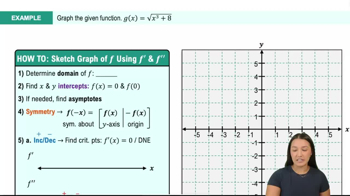Table of contents
- 0. Functions7h 52m
- Introduction to Functions16m
- Piecewise Functions10m
- Properties of Functions9m
- Common Functions1h 8m
- Transformations5m
- Combining Functions27m
- Exponent rules32m
- Exponential Functions28m
- Logarithmic Functions24m
- Properties of Logarithms34m
- Exponential & Logarithmic Equations35m
- Introduction to Trigonometric Functions38m
- Graphs of Trigonometric Functions44m
- Trigonometric Identities47m
- Inverse Trigonometric Functions48m
- 1. Limits and Continuity2h 2m
- 2. Intro to Derivatives1h 33m
- 3. Techniques of Differentiation3h 18m
- 4. Applications of Derivatives2h 38m
- 5. Graphical Applications of Derivatives6h 2m
- 6. Derivatives of Inverse, Exponential, & Logarithmic Functions2h 37m
- 7. Antiderivatives & Indefinite Integrals1h 26m
- 8. Definite Integrals3h 25m
5. Graphical Applications of Derivatives
Curve Sketching
Problem 31
Textbook Question
Graphing functions Use the guidelines of this section to make a complete graph of f.
f(x) = x²/(x - 2)
 Verified step by step guidance
Verified step by step guidance1
Identify the function f(x) = \frac{x^2}{x - 2} and determine its domain by finding values of x that make the denominator zero.
Calculate the vertical asymptote by setting the denominator equal to zero: x - 2 = 0, which gives x = 2.
Find the x-intercepts by setting the numerator equal to zero: x^2 = 0, which gives x = 0.
Determine the horizontal asymptote by analyzing the degrees of the numerator and denominator; since the degree of the numerator is greater than that of the denominator, there is no horizontal asymptote.
Evaluate the behavior of the function as x approaches the vertical asymptote from the left and right to understand the end behavior of the graph.
Was this helpful?

 11:41m
11:41mWatch next
Master Summary of Curve Sketching with a bite sized video explanation from Callie
Start learning




